Supply Chain Operations Management: Tesco & ASDA Stockout Analysis
VerifiedAdded on 2021/12/21
|15
|3287
|25
Report
AI Summary
This report analyzes the "on-self-availability" (OSA) and out-of-stock conditions in two major UK supermarkets, Tesco and ASDA, to understand their supply chain operations. The report begins with an introduction to OSA and its importance, followed by a description of the methodology, which includes secondary data analysis and store visits. The findings compare the stockout rates of products between the two supermarkets, highlighting differences in product availability. The data analysis explores potential supply chain issues causing stockouts, such as data synchronization problems, inventory management failures, and forecasting inaccuracies. The report also examines tools and techniques supermarkets use to reduce stockouts, like electronic inventory systems. Ultimately, the report aims to evaluate the efficiency of OSA in UK supermarkets, identify causes of stockouts, and explore solutions for improved inventory management and customer satisfaction. The report uses data from both online and in-store observations to evaluate the products and their availability.
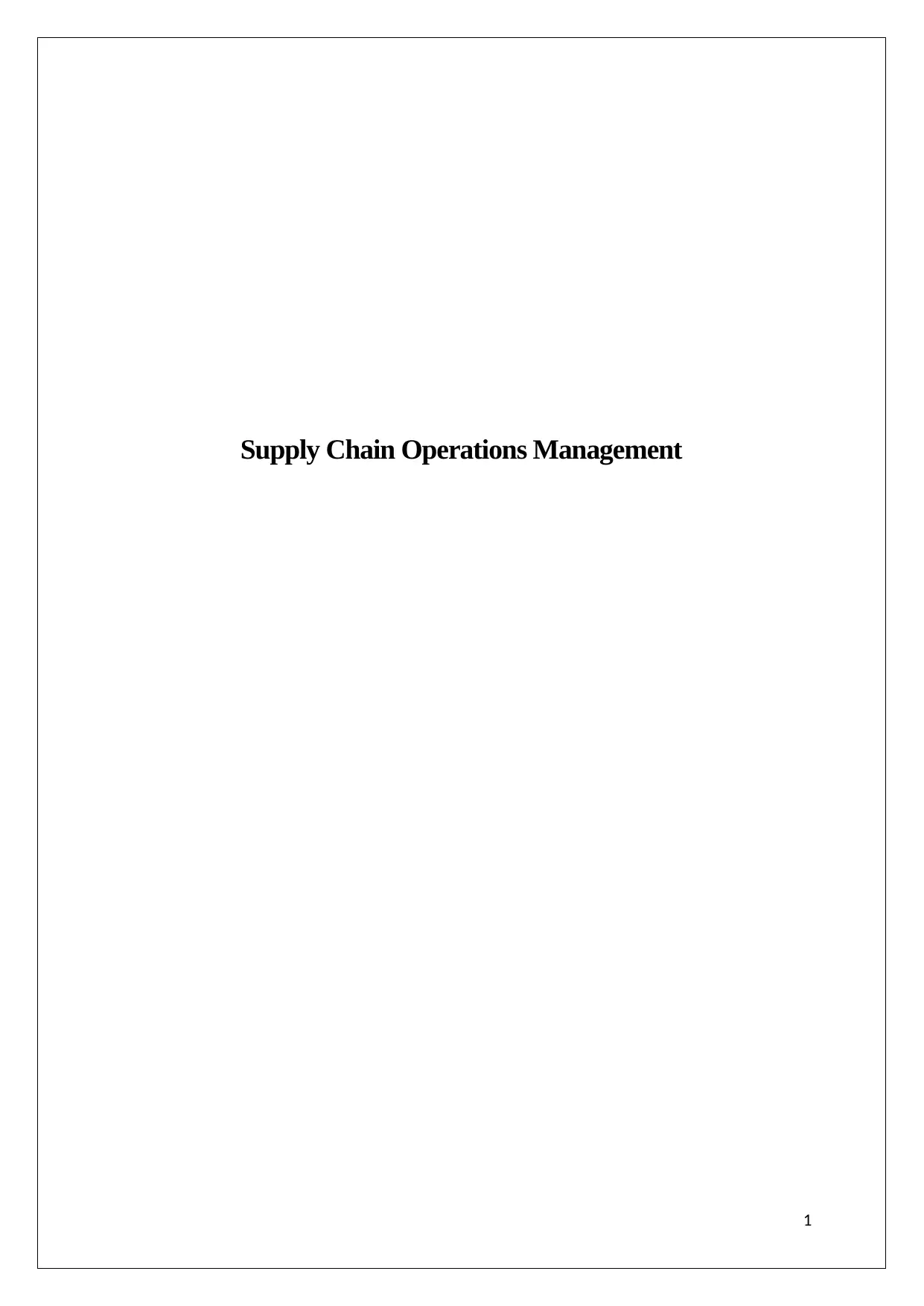
Supply Chain Operations Management
1
1
Paraphrase This Document
Need a fresh take? Get an instant paraphrase of this document with our AI Paraphraser
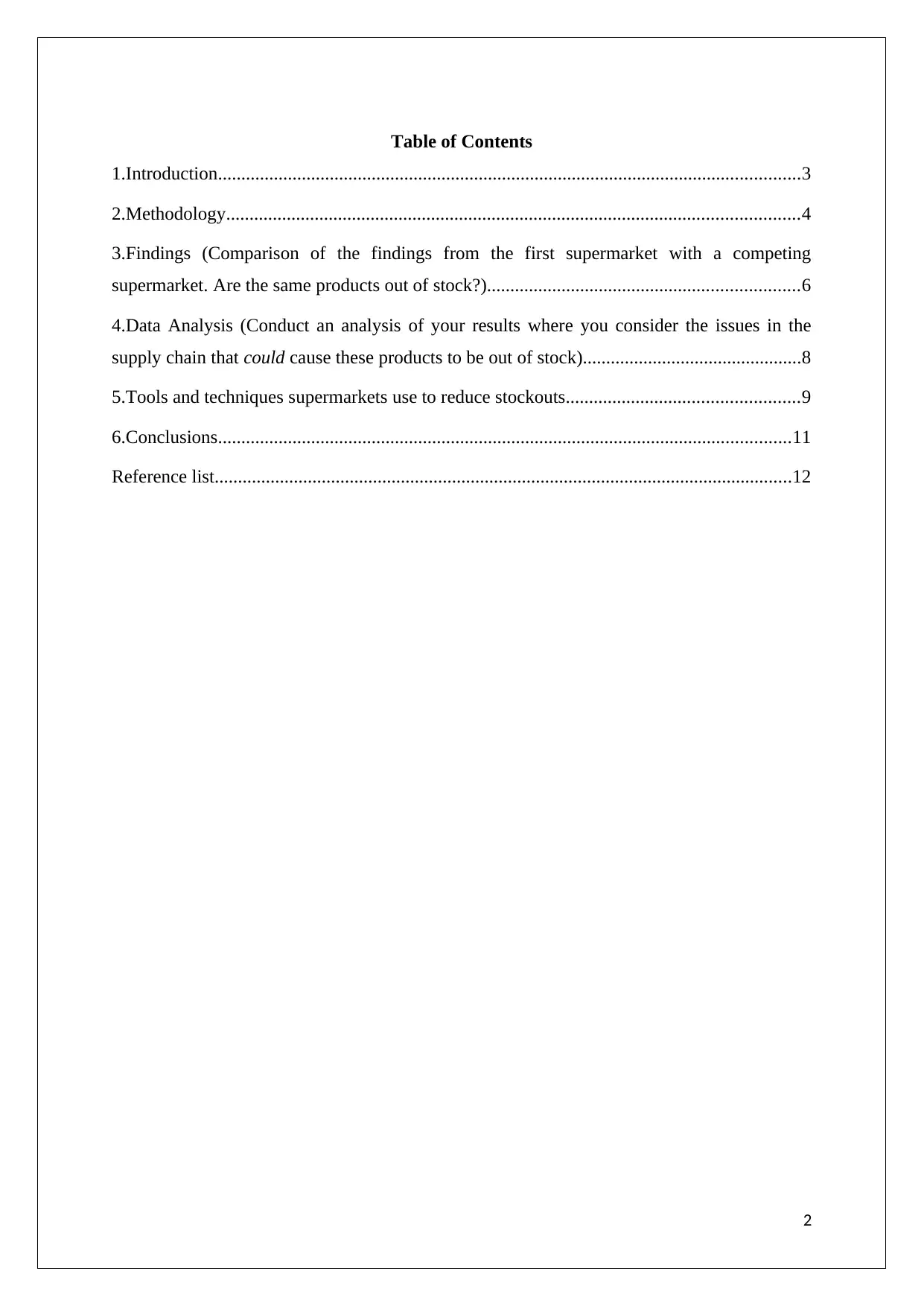
Table of Contents
1.Introduction.............................................................................................................................3
2.Methodology...........................................................................................................................4
3.Findings (Comparison of the findings from the first supermarket with a competing
supermarket. Are the same products out of stock?)...................................................................6
4.Data Analysis (Conduct an analysis of your results where you consider the issues in the
supply chain that could cause these products to be out of stock)...............................................8
5.Tools and techniques supermarkets use to reduce stockouts..................................................9
6.Conclusions...........................................................................................................................11
Reference list............................................................................................................................12
2
1.Introduction.............................................................................................................................3
2.Methodology...........................................................................................................................4
3.Findings (Comparison of the findings from the first supermarket with a competing
supermarket. Are the same products out of stock?)...................................................................6
4.Data Analysis (Conduct an analysis of your results where you consider the issues in the
supply chain that could cause these products to be out of stock)...............................................8
5.Tools and techniques supermarkets use to reduce stockouts..................................................9
6.Conclusions...........................................................................................................................11
Reference list............................................................................................................................12
2
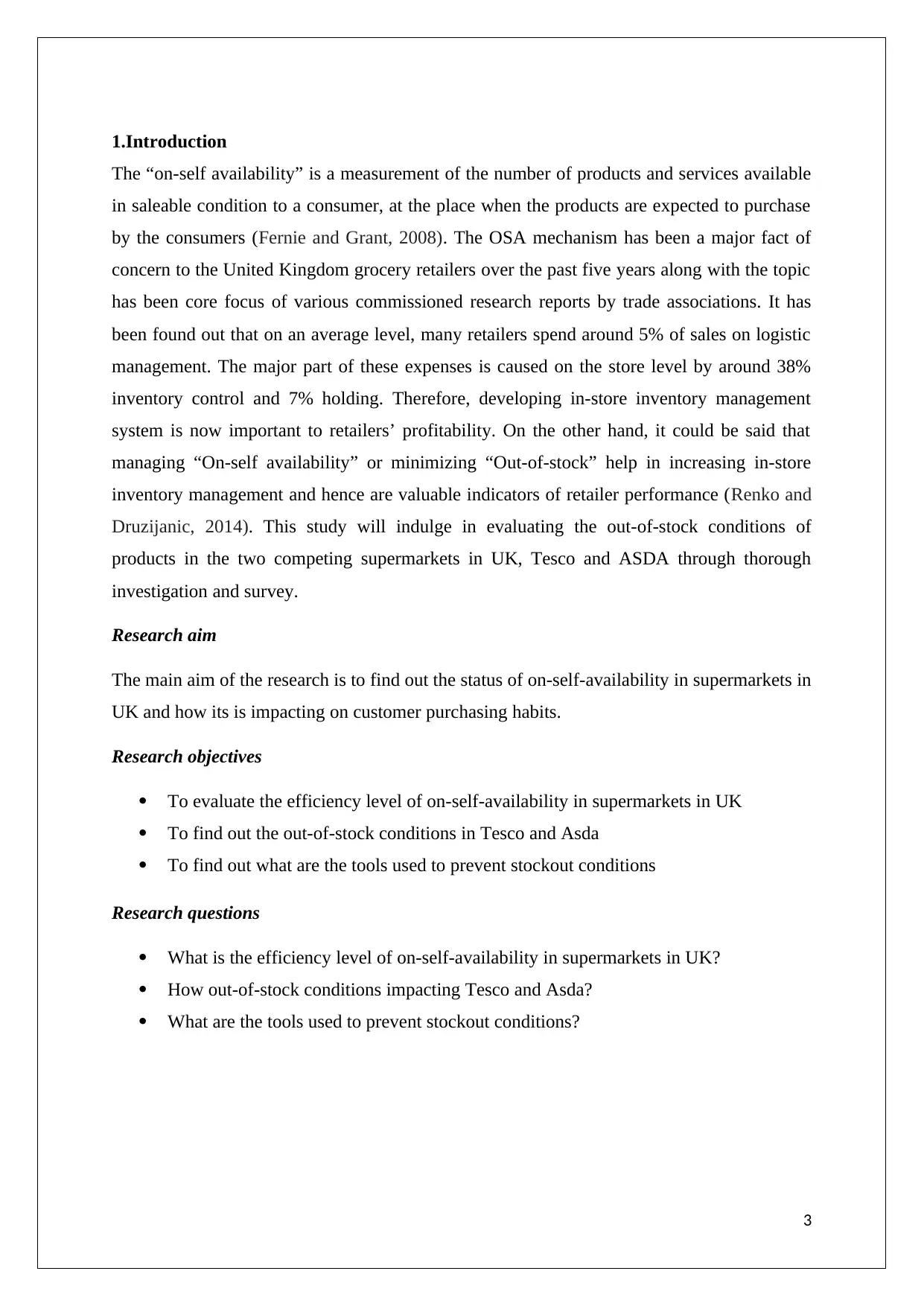
1.Introduction
The “on-self availability” is a measurement of the number of products and services available
in saleable condition to a consumer, at the place when the products are expected to purchase
by the consumers (Fernie and Grant, 2008). The OSA mechanism has been a major fact of
concern to the United Kingdom grocery retailers over the past five years along with the topic
has been core focus of various commissioned research reports by trade associations. It has
been found out that on an average level, many retailers spend around 5% of sales on logistic
management. The major part of these expenses is caused on the store level by around 38%
inventory control and 7% holding. Therefore, developing in-store inventory management
system is now important to retailers’ profitability. On the other hand, it could be said that
managing “On-self availability” or minimizing “Out-of-stock” help in increasing in-store
inventory management and hence are valuable indicators of retailer performance (Renko and
Druzijanic, 2014). This study will indulge in evaluating the out-of-stock conditions of
products in the two competing supermarkets in UK, Tesco and ASDA through thorough
investigation and survey.
Research aim
The main aim of the research is to find out the status of on-self-availability in supermarkets in
UK and how its is impacting on customer purchasing habits.
Research objectives
To evaluate the efficiency level of on-self-availability in supermarkets in UK
To find out the out-of-stock conditions in Tesco and Asda
To find out what are the tools used to prevent stockout conditions
Research questions
What is the efficiency level of on-self-availability in supermarkets in UK?
How out-of-stock conditions impacting Tesco and Asda?
What are the tools used to prevent stockout conditions?
3
The “on-self availability” is a measurement of the number of products and services available
in saleable condition to a consumer, at the place when the products are expected to purchase
by the consumers (Fernie and Grant, 2008). The OSA mechanism has been a major fact of
concern to the United Kingdom grocery retailers over the past five years along with the topic
has been core focus of various commissioned research reports by trade associations. It has
been found out that on an average level, many retailers spend around 5% of sales on logistic
management. The major part of these expenses is caused on the store level by around 38%
inventory control and 7% holding. Therefore, developing in-store inventory management
system is now important to retailers’ profitability. On the other hand, it could be said that
managing “On-self availability” or minimizing “Out-of-stock” help in increasing in-store
inventory management and hence are valuable indicators of retailer performance (Renko and
Druzijanic, 2014). This study will indulge in evaluating the out-of-stock conditions of
products in the two competing supermarkets in UK, Tesco and ASDA through thorough
investigation and survey.
Research aim
The main aim of the research is to find out the status of on-self-availability in supermarkets in
UK and how its is impacting on customer purchasing habits.
Research objectives
To evaluate the efficiency level of on-self-availability in supermarkets in UK
To find out the out-of-stock conditions in Tesco and Asda
To find out what are the tools used to prevent stockout conditions
Research questions
What is the efficiency level of on-self-availability in supermarkets in UK?
How out-of-stock conditions impacting Tesco and Asda?
What are the tools used to prevent stockout conditions?
3
⊘ This is a preview!⊘
Do you want full access?
Subscribe today to unlock all pages.

Trusted by 1+ million students worldwide

4
Paraphrase This Document
Need a fresh take? Get an instant paraphrase of this document with our AI Paraphraser
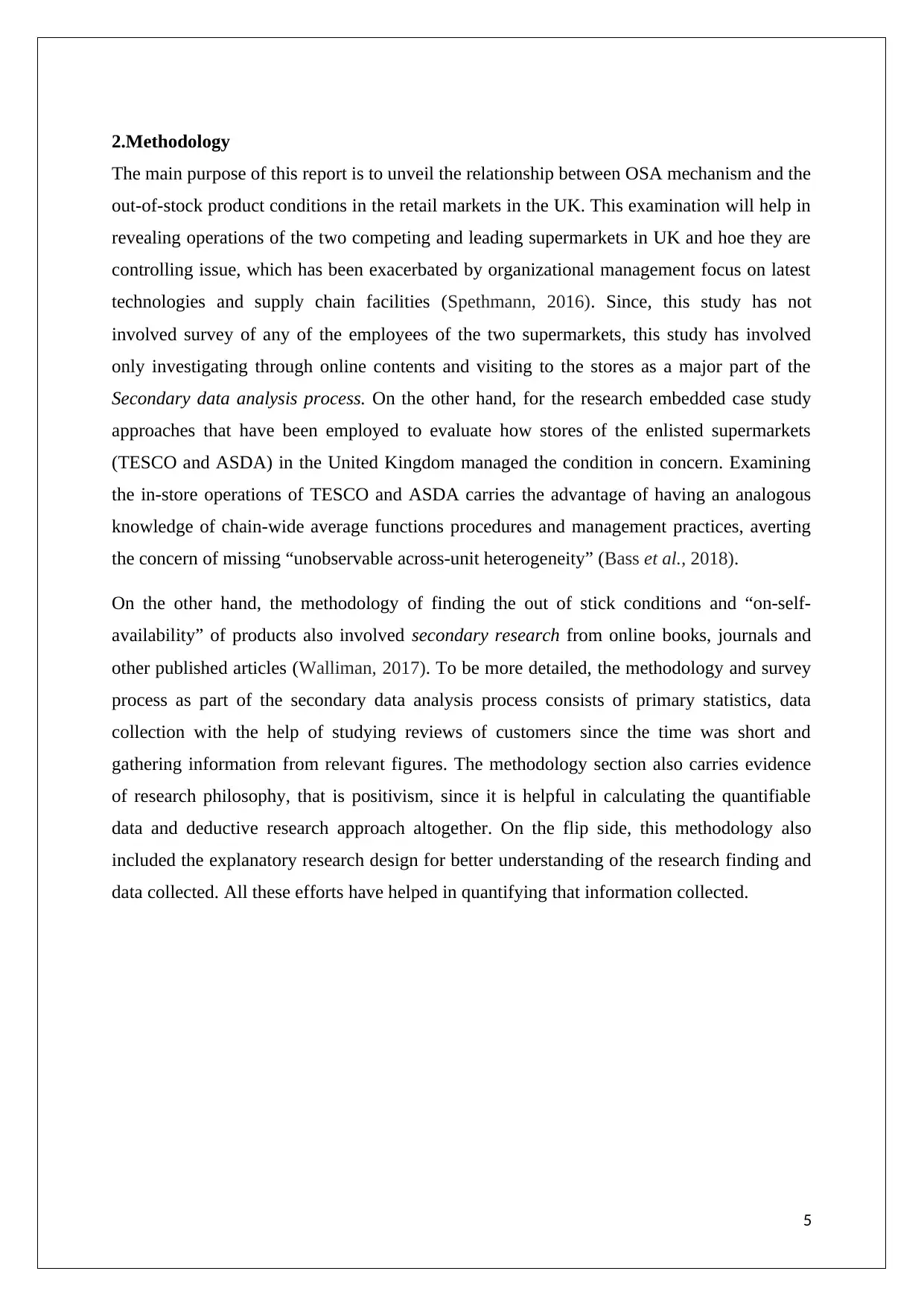
2.Methodology
The main purpose of this report is to unveil the relationship between OSA mechanism and the
out-of-stock product conditions in the retail markets in the UK. This examination will help in
revealing operations of the two competing and leading supermarkets in UK and hoe they are
controlling issue, which has been exacerbated by organizational management focus on latest
technologies and supply chain facilities (Spethmann, 2016). Since, this study has not
involved survey of any of the employees of the two supermarkets, this study has involved
only investigating through online contents and visiting to the stores as a major part of the
Secondary data analysis process. On the other hand, for the research embedded case study
approaches that have been employed to evaluate how stores of the enlisted supermarkets
(TESCO and ASDA) in the United Kingdom managed the condition in concern. Examining
the in-store operations of TESCO and ASDA carries the advantage of having an analogous
knowledge of chain-wide average functions procedures and management practices, averting
the concern of missing “unobservable across-unit heterogeneity” (Bass et al., 2018).
On the other hand, the methodology of finding the out of stick conditions and “on-self-
availability” of products also involved secondary research from online books, journals and
other published articles (Walliman, 2017). To be more detailed, the methodology and survey
process as part of the secondary data analysis process consists of primary statistics, data
collection with the help of studying reviews of customers since the time was short and
gathering information from relevant figures. The methodology section also carries evidence
of research philosophy, that is positivism, since it is helpful in calculating the quantifiable
data and deductive research approach altogether. On the flip side, this methodology also
included the explanatory research design for better understanding of the research finding and
data collected. All these efforts have helped in quantifying that information collected.
5
The main purpose of this report is to unveil the relationship between OSA mechanism and the
out-of-stock product conditions in the retail markets in the UK. This examination will help in
revealing operations of the two competing and leading supermarkets in UK and hoe they are
controlling issue, which has been exacerbated by organizational management focus on latest
technologies and supply chain facilities (Spethmann, 2016). Since, this study has not
involved survey of any of the employees of the two supermarkets, this study has involved
only investigating through online contents and visiting to the stores as a major part of the
Secondary data analysis process. On the other hand, for the research embedded case study
approaches that have been employed to evaluate how stores of the enlisted supermarkets
(TESCO and ASDA) in the United Kingdom managed the condition in concern. Examining
the in-store operations of TESCO and ASDA carries the advantage of having an analogous
knowledge of chain-wide average functions procedures and management practices, averting
the concern of missing “unobservable across-unit heterogeneity” (Bass et al., 2018).
On the other hand, the methodology of finding the out of stick conditions and “on-self-
availability” of products also involved secondary research from online books, journals and
other published articles (Walliman, 2017). To be more detailed, the methodology and survey
process as part of the secondary data analysis process consists of primary statistics, data
collection with the help of studying reviews of customers since the time was short and
gathering information from relevant figures. The methodology section also carries evidence
of research philosophy, that is positivism, since it is helpful in calculating the quantifiable
data and deductive research approach altogether. On the flip side, this methodology also
included the explanatory research design for better understanding of the research finding and
data collected. All these efforts have helped in quantifying that information collected.
5
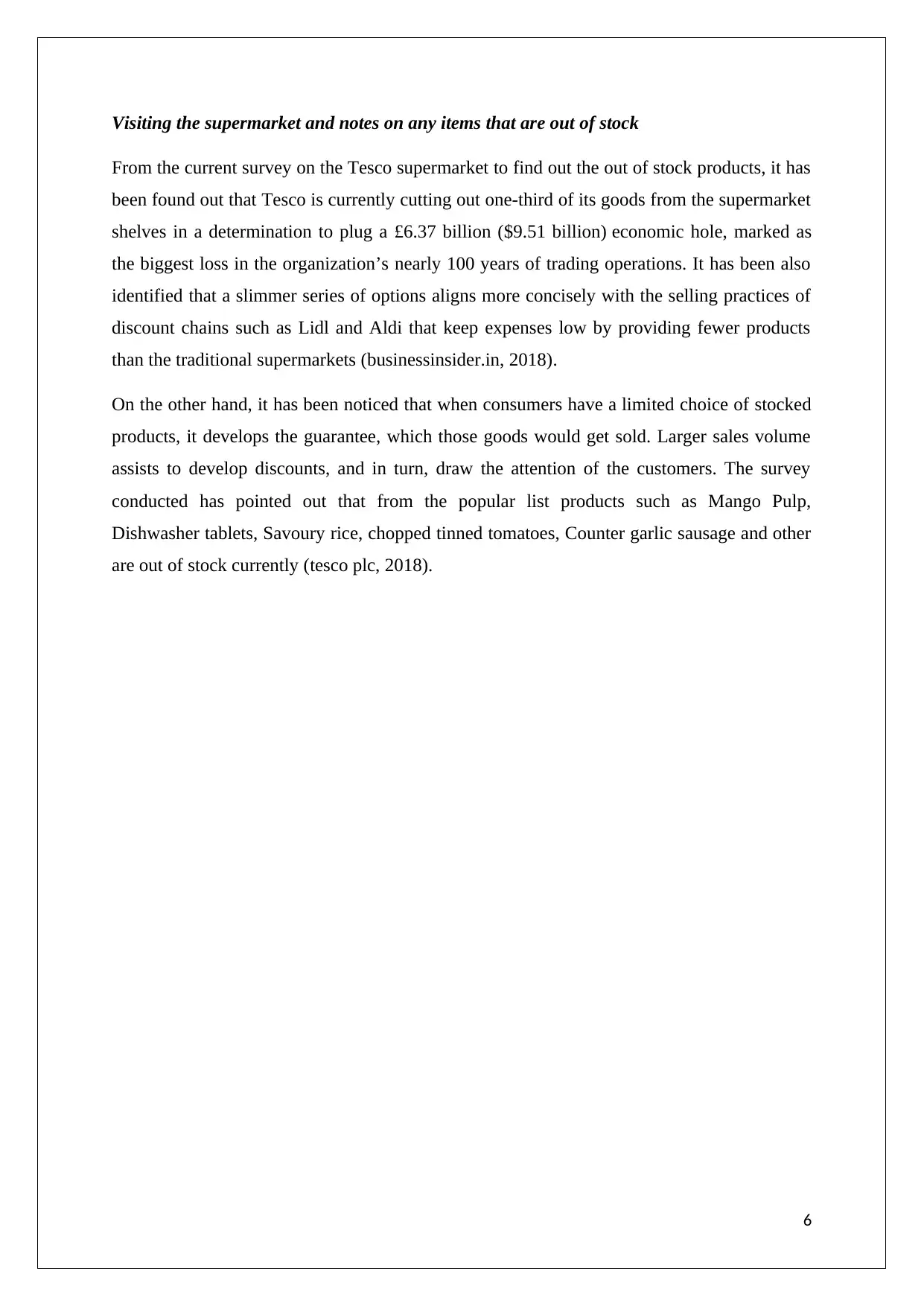
Visiting the supermarket and notes on any items that are out of stock
From the current survey on the Tesco supermarket to find out the out of stock products, it has
been found out that Tesco is currently cutting out one-third of its goods from the supermarket
shelves in a determination to plug a £6.37 billion ($9.51 billion) economic hole, marked as
the biggest loss in the organization’s nearly 100 years of trading operations. It has been also
identified that a slimmer series of options aligns more concisely with the selling practices of
discount chains such as Lidl and Aldi that keep expenses low by providing fewer products
than the traditional supermarkets (businessinsider.in, 2018).
On the other hand, it has been noticed that when consumers have a limited choice of stocked
products, it develops the guarantee, which those goods would get sold. Larger sales volume
assists to develop discounts, and in turn, draw the attention of the customers. The survey
conducted has pointed out that from the popular list products such as Mango Pulp,
Dishwasher tablets, Savoury rice, chopped tinned tomatoes, Counter garlic sausage and other
are out of stock currently (tesco plc, 2018).
6
From the current survey on the Tesco supermarket to find out the out of stock products, it has
been found out that Tesco is currently cutting out one-third of its goods from the supermarket
shelves in a determination to plug a £6.37 billion ($9.51 billion) economic hole, marked as
the biggest loss in the organization’s nearly 100 years of trading operations. It has been also
identified that a slimmer series of options aligns more concisely with the selling practices of
discount chains such as Lidl and Aldi that keep expenses low by providing fewer products
than the traditional supermarkets (businessinsider.in, 2018).
On the other hand, it has been noticed that when consumers have a limited choice of stocked
products, it develops the guarantee, which those goods would get sold. Larger sales volume
assists to develop discounts, and in turn, draw the attention of the customers. The survey
conducted has pointed out that from the popular list products such as Mango Pulp,
Dishwasher tablets, Savoury rice, chopped tinned tomatoes, Counter garlic sausage and other
are out of stock currently (tesco plc, 2018).
6
⊘ This is a preview!⊘
Do you want full access?
Subscribe today to unlock all pages.

Trusted by 1+ million students worldwide
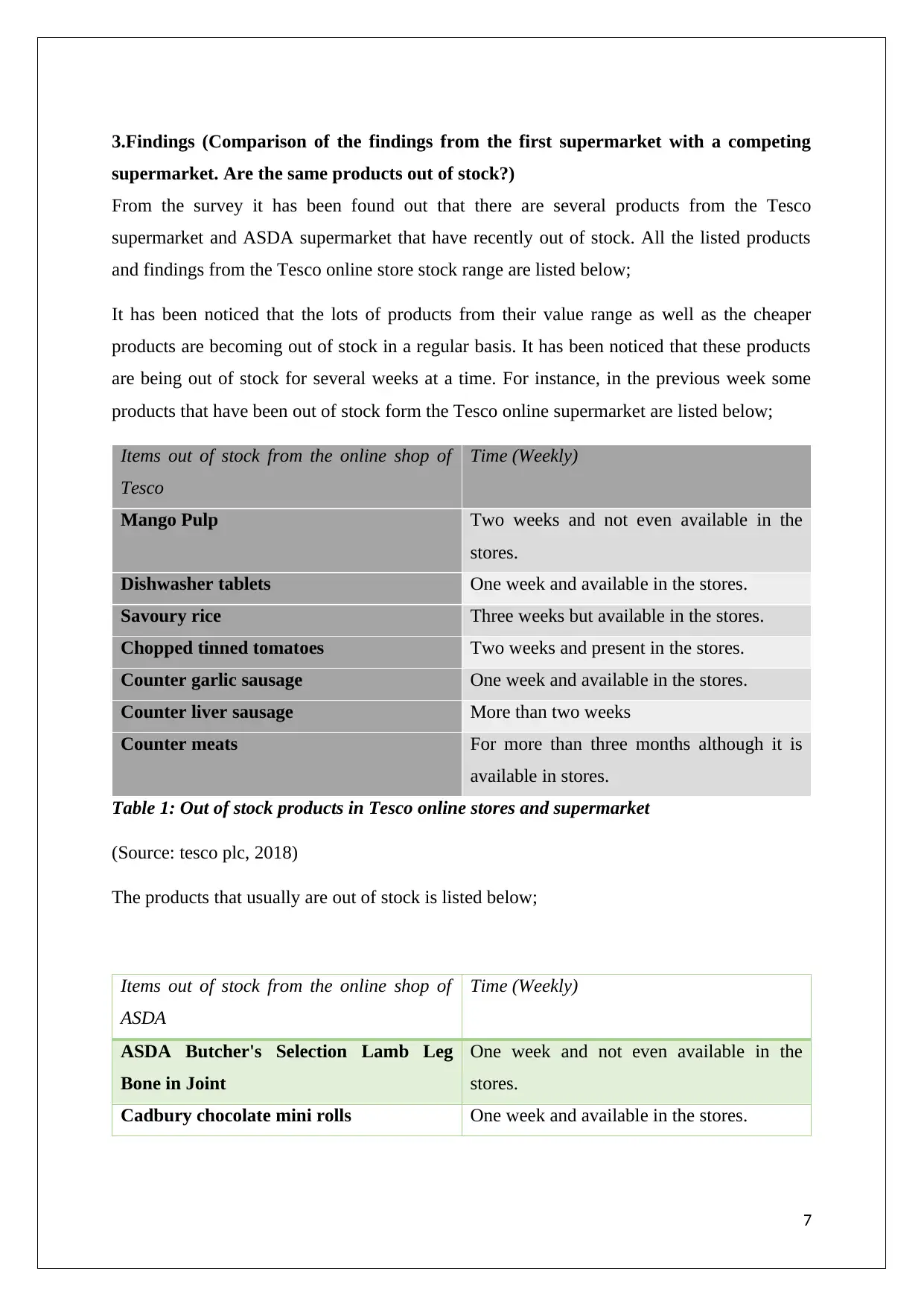
3.Findings (Comparison of the findings from the first supermarket with a competing
supermarket. Are the same products out of stock?)
From the survey it has been found out that there are several products from the Tesco
supermarket and ASDA supermarket that have recently out of stock. All the listed products
and findings from the Tesco online store stock range are listed below;
It has been noticed that the lots of products from their value range as well as the cheaper
products are becoming out of stock in a regular basis. It has been noticed that these products
are being out of stock for several weeks at a time. For instance, in the previous week some
products that have been out of stock form the Tesco online supermarket are listed below;
Items out of stock from the online shop of
Tesco
Time (Weekly)
Mango Pulp Two weeks and not even available in the
stores.
Dishwasher tablets One week and available in the stores.
Savoury rice Three weeks but available in the stores.
Chopped tinned tomatoes Two weeks and present in the stores.
Counter garlic sausage One week and available in the stores.
Counter liver sausage More than two weeks
Counter meats For more than three months although it is
available in stores.
Table 1: Out of stock products in Tesco online stores and supermarket
(Source: tesco plc, 2018)
The products that usually are out of stock is listed below;
Items out of stock from the online shop of
ASDA
Time (Weekly)
ASDA Butcher's Selection Lamb Leg
Bone in Joint
One week and not even available in the
stores.
Cadbury chocolate mini rolls One week and available in the stores.
7
supermarket. Are the same products out of stock?)
From the survey it has been found out that there are several products from the Tesco
supermarket and ASDA supermarket that have recently out of stock. All the listed products
and findings from the Tesco online store stock range are listed below;
It has been noticed that the lots of products from their value range as well as the cheaper
products are becoming out of stock in a regular basis. It has been noticed that these products
are being out of stock for several weeks at a time. For instance, in the previous week some
products that have been out of stock form the Tesco online supermarket are listed below;
Items out of stock from the online shop of
Tesco
Time (Weekly)
Mango Pulp Two weeks and not even available in the
stores.
Dishwasher tablets One week and available in the stores.
Savoury rice Three weeks but available in the stores.
Chopped tinned tomatoes Two weeks and present in the stores.
Counter garlic sausage One week and available in the stores.
Counter liver sausage More than two weeks
Counter meats For more than three months although it is
available in stores.
Table 1: Out of stock products in Tesco online stores and supermarket
(Source: tesco plc, 2018)
The products that usually are out of stock is listed below;
Items out of stock from the online shop of
ASDA
Time (Weekly)
ASDA Butcher's Selection Lamb Leg
Bone in Joint
One week and not even available in the
stores.
Cadbury chocolate mini rolls One week and available in the stores.
7
Paraphrase This Document
Need a fresh take? Get an instant paraphrase of this document with our AI Paraphraser
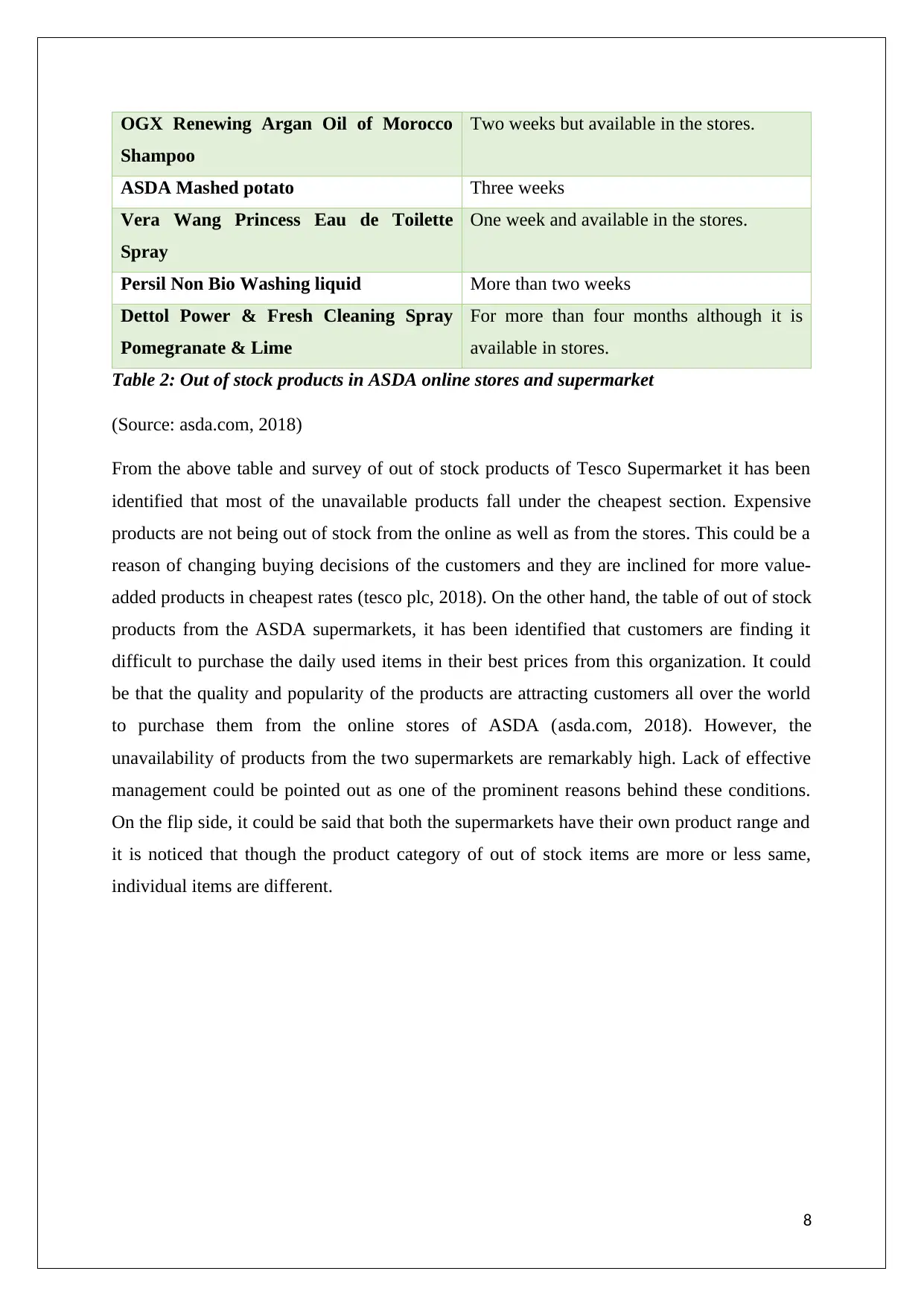
OGX Renewing Argan Oil of Morocco
Shampoo
Two weeks but available in the stores.
ASDA Mashed potato Three weeks
Vera Wang Princess Eau de Toilette
Spray
One week and available in the stores.
Persil Non Bio Washing liquid More than two weeks
Dettol Power & Fresh Cleaning Spray
Pomegranate & Lime
For more than four months although it is
available in stores.
Table 2: Out of stock products in ASDA online stores and supermarket
(Source: asda.com, 2018)
From the above table and survey of out of stock products of Tesco Supermarket it has been
identified that most of the unavailable products fall under the cheapest section. Expensive
products are not being out of stock from the online as well as from the stores. This could be a
reason of changing buying decisions of the customers and they are inclined for more value-
added products in cheapest rates (tesco plc, 2018). On the other hand, the table of out of stock
products from the ASDA supermarkets, it has been identified that customers are finding it
difficult to purchase the daily used items in their best prices from this organization. It could
be that the quality and popularity of the products are attracting customers all over the world
to purchase them from the online stores of ASDA (asda.com, 2018). However, the
unavailability of products from the two supermarkets are remarkably high. Lack of effective
management could be pointed out as one of the prominent reasons behind these conditions.
On the flip side, it could be said that both the supermarkets have their own product range and
it is noticed that though the product category of out of stock items are more or less same,
individual items are different.
8
Shampoo
Two weeks but available in the stores.
ASDA Mashed potato Three weeks
Vera Wang Princess Eau de Toilette
Spray
One week and available in the stores.
Persil Non Bio Washing liquid More than two weeks
Dettol Power & Fresh Cleaning Spray
Pomegranate & Lime
For more than four months although it is
available in stores.
Table 2: Out of stock products in ASDA online stores and supermarket
(Source: asda.com, 2018)
From the above table and survey of out of stock products of Tesco Supermarket it has been
identified that most of the unavailable products fall under the cheapest section. Expensive
products are not being out of stock from the online as well as from the stores. This could be a
reason of changing buying decisions of the customers and they are inclined for more value-
added products in cheapest rates (tesco plc, 2018). On the other hand, the table of out of stock
products from the ASDA supermarkets, it has been identified that customers are finding it
difficult to purchase the daily used items in their best prices from this organization. It could
be that the quality and popularity of the products are attracting customers all over the world
to purchase them from the online stores of ASDA (asda.com, 2018). However, the
unavailability of products from the two supermarkets are remarkably high. Lack of effective
management could be pointed out as one of the prominent reasons behind these conditions.
On the flip side, it could be said that both the supermarkets have their own product range and
it is noticed that though the product category of out of stock items are more or less same,
individual items are different.
8
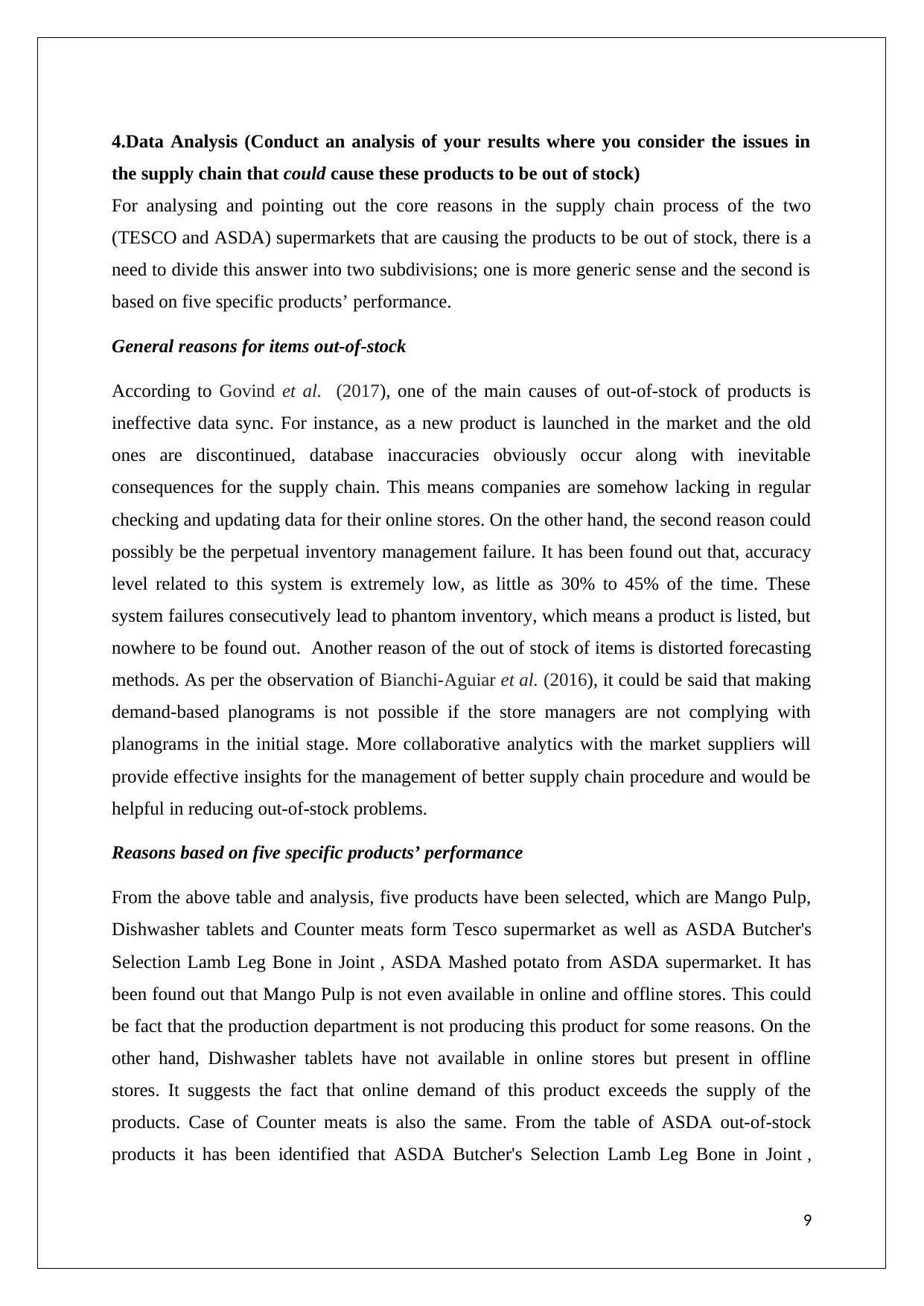
4.Data Analysis (Conduct an analysis of your results where you consider the issues in
the supply chain that could cause these products to be out of stock)
For analysing and pointing out the core reasons in the supply chain process of the two
(TESCO and ASDA) supermarkets that are causing the products to be out of stock, there is a
need to divide this answer into two subdivisions; one is more generic sense and the second is
based on five specific products’ performance.
General reasons for items out-of-stock
According to Govind et al. (2017), one of the main causes of out-of-stock of products is
ineffective data sync. For instance, as a new product is launched in the market and the old
ones are discontinued, database inaccuracies obviously occur along with inevitable
consequences for the supply chain. This means companies are somehow lacking in regular
checking and updating data for their online stores. On the other hand, the second reason could
possibly be the perpetual inventory management failure. It has been found out that, accuracy
level related to this system is extremely low, as little as 30% to 45% of the time. These
system failures consecutively lead to phantom inventory, which means a product is listed, but
nowhere to be found out. Another reason of the out of stock of items is distorted forecasting
methods. As per the observation of Bianchi-Aguiar et al. (2016), it could be said that making
demand-based planograms is not possible if the store managers are not complying with
planograms in the initial stage. More collaborative analytics with the market suppliers will
provide effective insights for the management of better supply chain procedure and would be
helpful in reducing out-of-stock problems.
Reasons based on five specific products’ performance
From the above table and analysis, five products have been selected, which are Mango Pulp,
Dishwasher tablets and Counter meats form Tesco supermarket as well as ASDA Butcher's
Selection Lamb Leg Bone in Joint , ASDA Mashed potato from ASDA supermarket. It has
been found out that Mango Pulp is not even available in online and offline stores. This could
be fact that the production department is not producing this product for some reasons. On the
other hand, Dishwasher tablets have not available in online stores but present in offline
stores. It suggests the fact that online demand of this product exceeds the supply of the
products. Case of Counter meats is also the same. From the table of ASDA out-of-stock
products it has been identified that ASDA Butcher's Selection Lamb Leg Bone in Joint ,
9
the supply chain that could cause these products to be out of stock)
For analysing and pointing out the core reasons in the supply chain process of the two
(TESCO and ASDA) supermarkets that are causing the products to be out of stock, there is a
need to divide this answer into two subdivisions; one is more generic sense and the second is
based on five specific products’ performance.
General reasons for items out-of-stock
According to Govind et al. (2017), one of the main causes of out-of-stock of products is
ineffective data sync. For instance, as a new product is launched in the market and the old
ones are discontinued, database inaccuracies obviously occur along with inevitable
consequences for the supply chain. This means companies are somehow lacking in regular
checking and updating data for their online stores. On the other hand, the second reason could
possibly be the perpetual inventory management failure. It has been found out that, accuracy
level related to this system is extremely low, as little as 30% to 45% of the time. These
system failures consecutively lead to phantom inventory, which means a product is listed, but
nowhere to be found out. Another reason of the out of stock of items is distorted forecasting
methods. As per the observation of Bianchi-Aguiar et al. (2016), it could be said that making
demand-based planograms is not possible if the store managers are not complying with
planograms in the initial stage. More collaborative analytics with the market suppliers will
provide effective insights for the management of better supply chain procedure and would be
helpful in reducing out-of-stock problems.
Reasons based on five specific products’ performance
From the above table and analysis, five products have been selected, which are Mango Pulp,
Dishwasher tablets and Counter meats form Tesco supermarket as well as ASDA Butcher's
Selection Lamb Leg Bone in Joint , ASDA Mashed potato from ASDA supermarket. It has
been found out that Mango Pulp is not even available in online and offline stores. This could
be fact that the production department is not producing this product for some reasons. On the
other hand, Dishwasher tablets have not available in online stores but present in offline
stores. It suggests the fact that online demand of this product exceeds the supply of the
products. Case of Counter meats is also the same. From the table of ASDA out-of-stock
products it has been identified that ASDA Butcher's Selection Lamb Leg Bone in Joint ,
9
⊘ This is a preview!⊘
Do you want full access?
Subscribe today to unlock all pages.

Trusted by 1+ million students worldwide
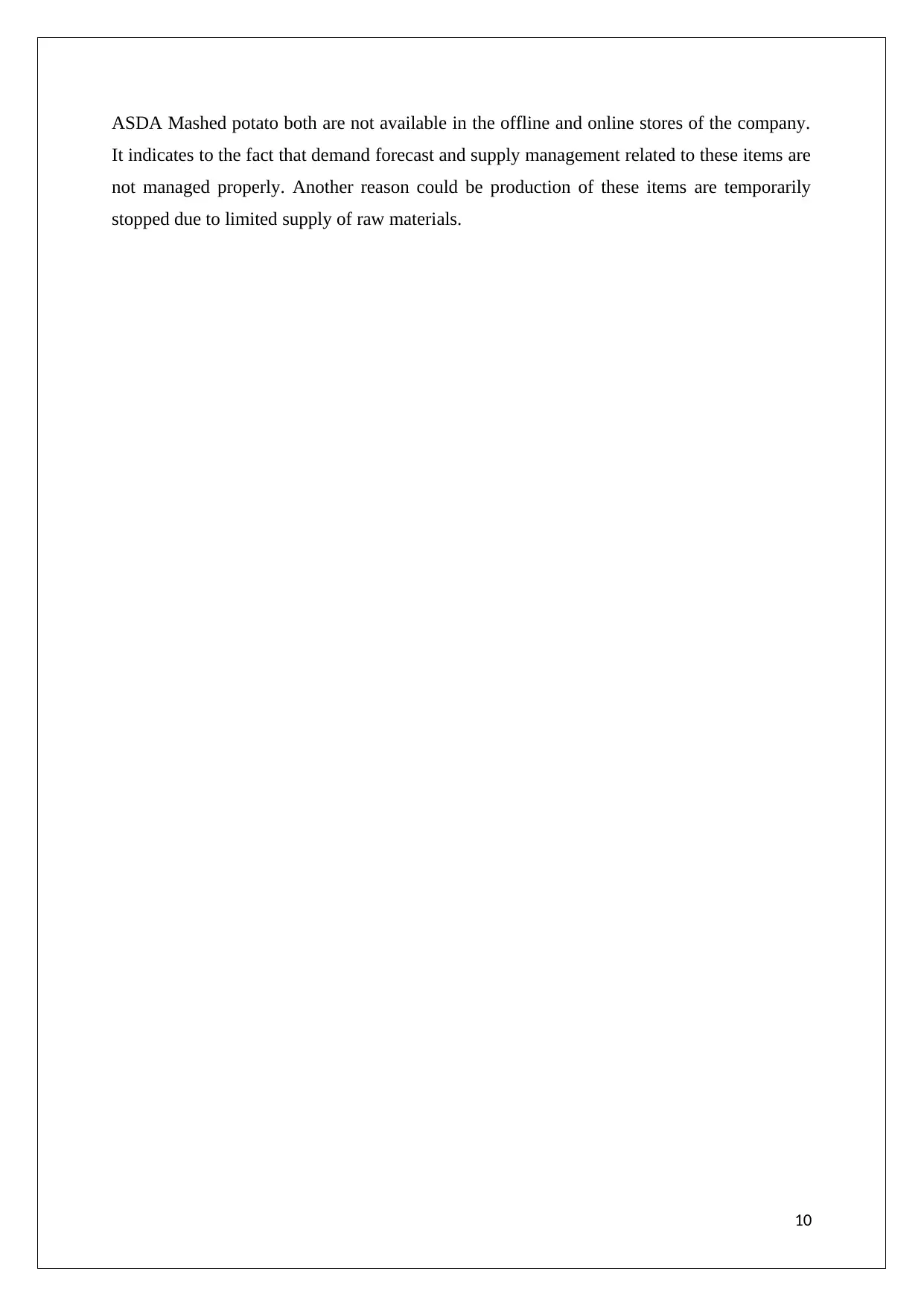
ASDA Mashed potato both are not available in the offline and online stores of the company.
It indicates to the fact that demand forecast and supply management related to these items are
not managed properly. Another reason could be production of these items are temporarily
stopped due to limited supply of raw materials.
10
It indicates to the fact that demand forecast and supply management related to these items are
not managed properly. Another reason could be production of these items are temporarily
stopped due to limited supply of raw materials.
10
Paraphrase This Document
Need a fresh take? Get an instant paraphrase of this document with our AI Paraphraser
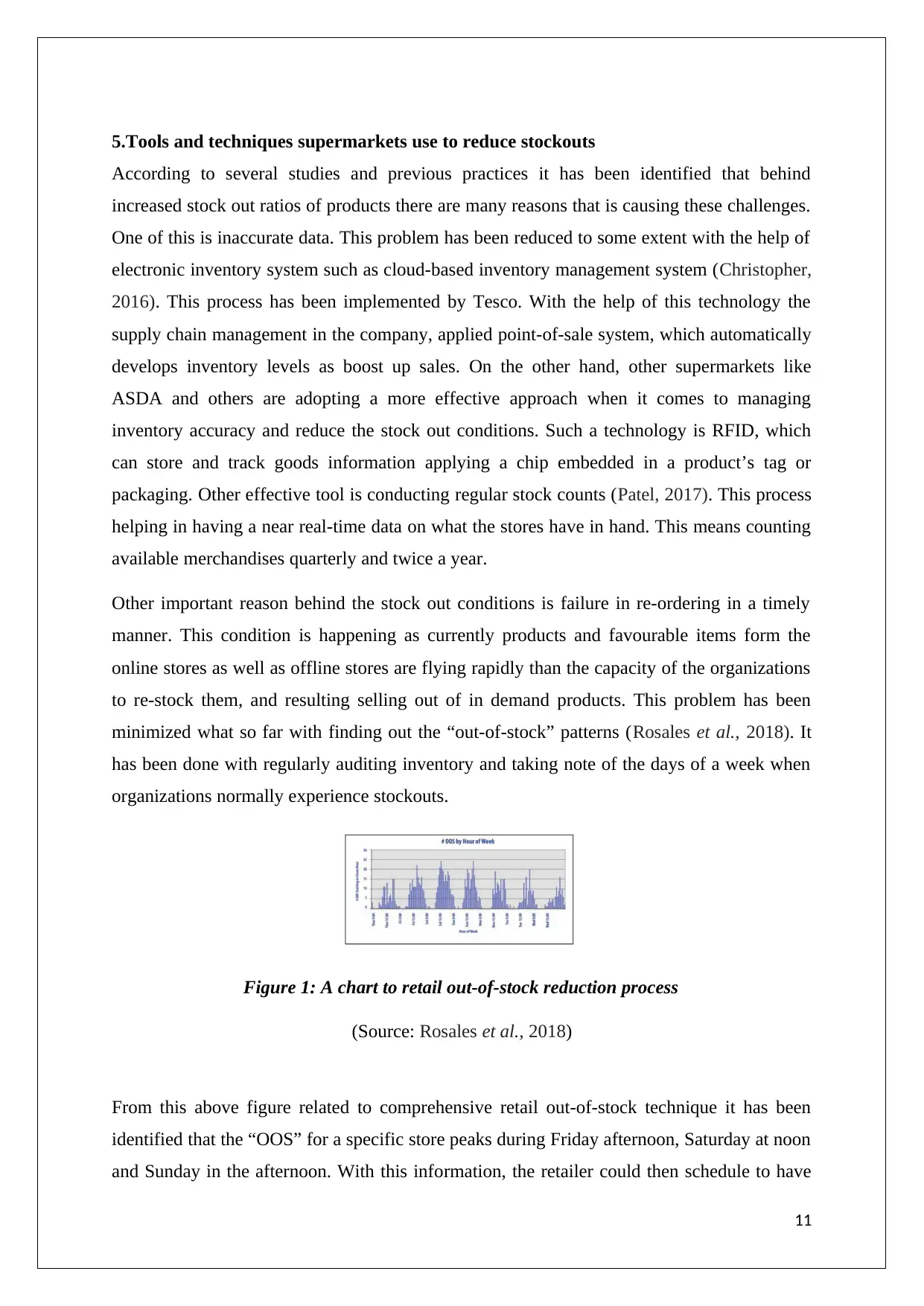
5.Tools and techniques supermarkets use to reduce stockouts
According to several studies and previous practices it has been identified that behind
increased stock out ratios of products there are many reasons that is causing these challenges.
One of this is inaccurate data. This problem has been reduced to some extent with the help of
electronic inventory system such as cloud-based inventory management system (Christopher,
2016). This process has been implemented by Tesco. With the help of this technology the
supply chain management in the company, applied point-of-sale system, which automatically
develops inventory levels as boost up sales. On the other hand, other supermarkets like
ASDA and others are adopting a more effective approach when it comes to managing
inventory accuracy and reduce the stock out conditions. Such a technology is RFID, which
can store and track goods information applying a chip embedded in a product’s tag or
packaging. Other effective tool is conducting regular stock counts (Patel, 2017). This process
helping in having a near real-time data on what the stores have in hand. This means counting
available merchandises quarterly and twice a year.
Other important reason behind the stock out conditions is failure in re-ordering in a timely
manner. This condition is happening as currently products and favourable items form the
online stores as well as offline stores are flying rapidly than the capacity of the organizations
to re-stock them, and resulting selling out of in demand products. This problem has been
minimized what so far with finding out the “out-of-stock” patterns (Rosales et al., 2018). It
has been done with regularly auditing inventory and taking note of the days of a week when
organizations normally experience stockouts.
Figure 1: A chart to retail out-of-stock reduction process
(Source: Rosales et al., 2018)
From this above figure related to comprehensive retail out-of-stock technique it has been
identified that the “OOS” for a specific store peaks during Friday afternoon, Saturday at noon
and Sunday in the afternoon. With this information, the retailer could then schedule to have
11
According to several studies and previous practices it has been identified that behind
increased stock out ratios of products there are many reasons that is causing these challenges.
One of this is inaccurate data. This problem has been reduced to some extent with the help of
electronic inventory system such as cloud-based inventory management system (Christopher,
2016). This process has been implemented by Tesco. With the help of this technology the
supply chain management in the company, applied point-of-sale system, which automatically
develops inventory levels as boost up sales. On the other hand, other supermarkets like
ASDA and others are adopting a more effective approach when it comes to managing
inventory accuracy and reduce the stock out conditions. Such a technology is RFID, which
can store and track goods information applying a chip embedded in a product’s tag or
packaging. Other effective tool is conducting regular stock counts (Patel, 2017). This process
helping in having a near real-time data on what the stores have in hand. This means counting
available merchandises quarterly and twice a year.
Other important reason behind the stock out conditions is failure in re-ordering in a timely
manner. This condition is happening as currently products and favourable items form the
online stores as well as offline stores are flying rapidly than the capacity of the organizations
to re-stock them, and resulting selling out of in demand products. This problem has been
minimized what so far with finding out the “out-of-stock” patterns (Rosales et al., 2018). It
has been done with regularly auditing inventory and taking note of the days of a week when
organizations normally experience stockouts.
Figure 1: A chart to retail out-of-stock reduction process
(Source: Rosales et al., 2018)
From this above figure related to comprehensive retail out-of-stock technique it has been
identified that the “OOS” for a specific store peaks during Friday afternoon, Saturday at noon
and Sunday in the afternoon. With this information, the retailer could then schedule to have
11
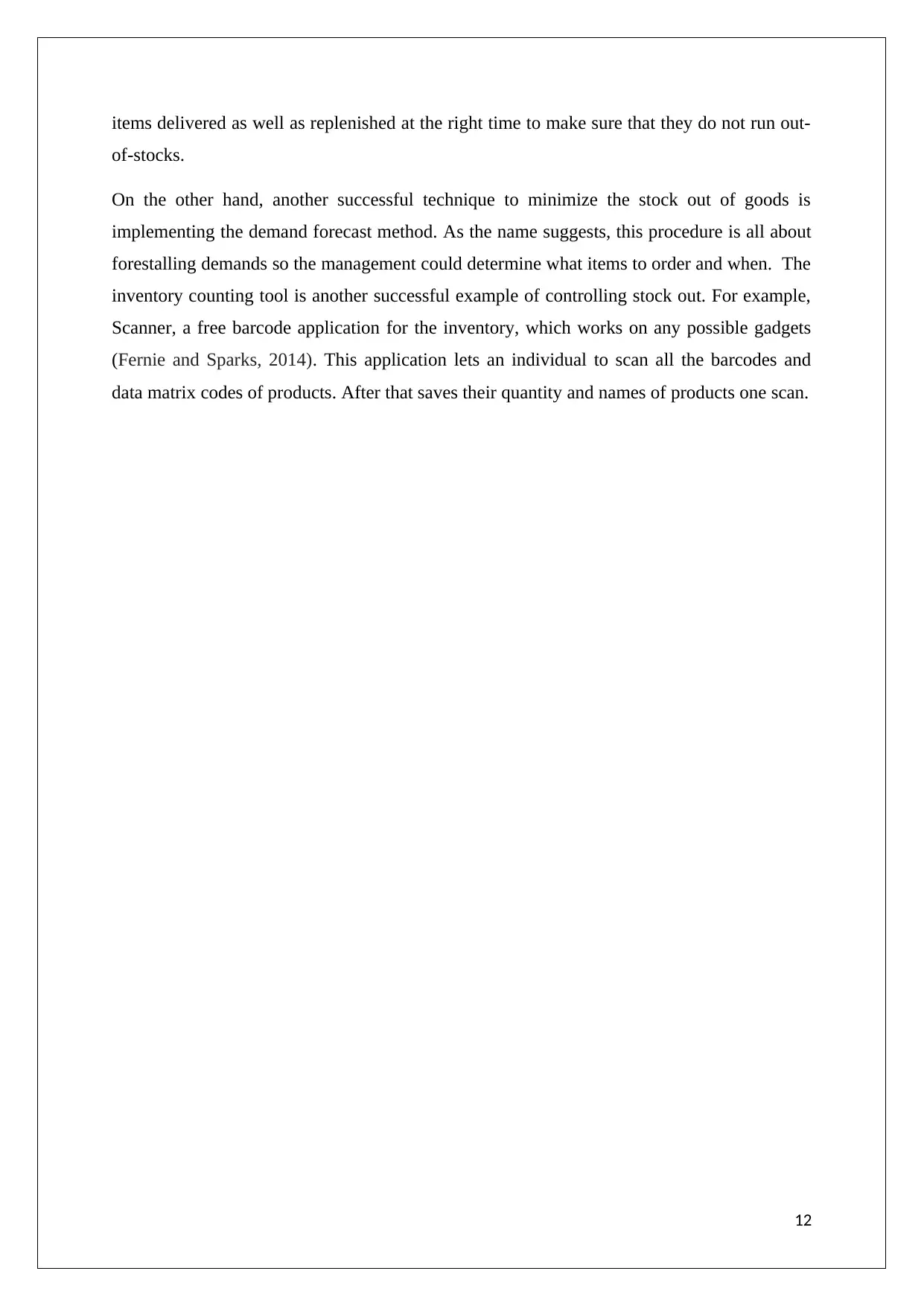
items delivered as well as replenished at the right time to make sure that they do not run out-
of-stocks.
On the other hand, another successful technique to minimize the stock out of goods is
implementing the demand forecast method. As the name suggests, this procedure is all about
forestalling demands so the management could determine what items to order and when. The
inventory counting tool is another successful example of controlling stock out. For example,
Scanner, a free barcode application for the inventory, which works on any possible gadgets
(Fernie and Sparks, 2014). This application lets an individual to scan all the barcodes and
data matrix codes of products. After that saves their quantity and names of products one scan.
12
of-stocks.
On the other hand, another successful technique to minimize the stock out of goods is
implementing the demand forecast method. As the name suggests, this procedure is all about
forestalling demands so the management could determine what items to order and when. The
inventory counting tool is another successful example of controlling stock out. For example,
Scanner, a free barcode application for the inventory, which works on any possible gadgets
(Fernie and Sparks, 2014). This application lets an individual to scan all the barcodes and
data matrix codes of products. After that saves their quantity and names of products one scan.
12
⊘ This is a preview!⊘
Do you want full access?
Subscribe today to unlock all pages.

Trusted by 1+ million students worldwide
1 out of 15
Related Documents
Your All-in-One AI-Powered Toolkit for Academic Success.
+13062052269
info@desklib.com
Available 24*7 on WhatsApp / Email
![[object Object]](/_next/static/media/star-bottom.7253800d.svg)
Unlock your academic potential
Copyright © 2020–2025 A2Z Services. All Rights Reserved. Developed and managed by ZUCOL.





